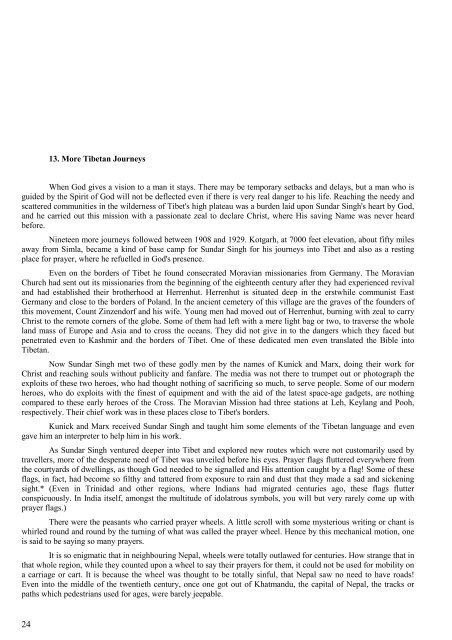Sadhu Sundar Singh A Biography
Sadhu Sundar Singh A Biography
Sadhu Sundar Singh A Biography
You also want an ePaper? Increase the reach of your titles
YUMPU automatically turns print PDFs into web optimized ePapers that Google loves.
24<br />
13. More Tibetan Journeys<br />
When God gives a vision to a man it stays. There may be temporary setbacks and delays, but a man who is<br />
guided by the Spirit of God will not be deflected even if there is very real danger to his life. Reaching the needy and<br />
scattered communities in the wilderness of Tibet's high plateau was a burden laid upon <strong>Sundar</strong> <strong>Singh</strong>'s heart by God,<br />
and he carried out this mission with a passionate zeal to declare Christ, where His saving Name was never heard<br />
before.<br />
Nineteen more journeys followed between 1908 and 1929. Kotgarh, at 7000 feet elevation, about fifty miles<br />
away from Simla, became a kind of base camp for <strong>Sundar</strong> <strong>Singh</strong> for his journeys into Tibet and also as a resting<br />
place for prayer, where he refuelled in God's presence.<br />
Even on the borders of Tibet he found consecrated Moravian missionaries from Germany. The Moravian<br />
Church had sent out its missionaries from the beginning of the eighteenth century after they had experienced revival<br />
and had established their brotherhood at Herrenhut. Herrenhut is situated deep in the erstwhile communist East<br />
Germany and close to the borders of Poland. In the ancient cemetery of this village are the graves of the founders of<br />
this movement, Count Zinzendorf and his wife. Young men had moved out of Herrenhut, burning with zeal to carry<br />
Christ to the remote corners of the globe. Some of them had left with a mere light bag or two, to traverse the whole<br />
land mass of Europe and Asia and to cross the oceans. They did not give in to the dangers which they faced but<br />
penetrated even to Kashmir and the borders of Tibet. One of these dedicated men even translated the Bible into<br />
Tibetan.<br />
Now <strong>Sundar</strong> <strong>Singh</strong> met two of these godly men by the names of Kunick and Marx, doing their work for<br />
Christ and reaching souls without publicity and fanfare. The media was not there to trumpet out or photograph the<br />
exploits of these two heroes, who had thought nothing of sacrificing so much, to serve people. Some of our modern<br />
heroes, who do exploits with the finest of equipment and with the aid of the latest space-age gadgets, are nothing<br />
compared to these early heroes of the Cross. The Moravian Mission had three stations at Leh, Keylang and Pooh,<br />
respectively. Their chief work was in these places close to Tibet's borders.<br />
Kunick and Marx received <strong>Sundar</strong> <strong>Singh</strong> and taught him some elements of the Tibetan language and even<br />
gave him an interpreter to help him in his work.<br />
As <strong>Sundar</strong> <strong>Singh</strong> ventured deeper into Tibet and explored new routes which were not customarily used by<br />
travellers, more of the desperate need of Tibet was unveiled before his eyes. Prayer flags fluttered everywhere from<br />
the courtyards of dwellings, as though God needed to be signalled and His attention caught by a flag! Some of these<br />
flags, in fact, had become so filthy and tattered from exposure to rain and dust that they made a sad and sickening<br />
sight.* (Even in Trinidad and other regions, where Indians had migrated centuries ago, these flags flutter<br />
conspicuously. In India itself, amongst the multitude of idolatrous symbols, you will but very rarely come up with<br />
prayer flags.)<br />
There were the peasants who carried prayer wheels. A little scroll with some mysterious writing or chant is<br />
whirled round and round by the turning of what was called the prayer wheel. Hence by this mechanical motion, one<br />
is said to be saying so many prayers.<br />
It is so enigmatic that in neighbouring Nepal, wheels were totally outlawed for centuries. How strange that in<br />
that whole region, while they counted upon a wheel to say their prayers for them, it could not be used for mobility on<br />
a carriage or cart. It is because the wheel was thought to be totally sinful, that Nepal saw no need to have roads!<br />
Even into the middle of the twentieth century, once one got out of Khatmandu, the capital of Nepal, the tracks or<br />
paths which pedestrians used for ages, were barely jeepable.


